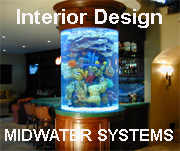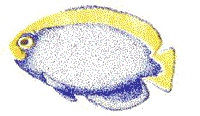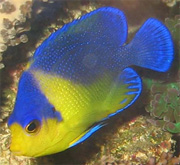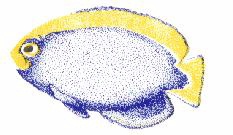|
The Tank
Let me state now that it is best to go as large
as the area you plan on placing the tank will accommodate, as size does
add one significant benefit, stability. The greater the volume the longer
it takes to alter it. This applies to many things, mainly water quality
and temperature.
I would not recommend setting up a saltwater fish tank
smaller than 55 / 60 gallons. Why, for two reasons; the above mentioned
reason, the lack stability in a small tank changes too fast, and the cost
to set up a smaller tank with the proper equipment and livestock is almost
as much as it would be for the larger tank. Think about it, what do you do with your equipment
when you have successfully completed your smaller fish tank and decide
you want to go bigger ? This is not to say that you cant have a small fish
tank and move its equipment over to a larger tank at a later time, but
chances are you may not be as successful with the smaller aquarium thus
leading to not perusing the larger tank.
There are a wide variety of tanks and they come
in many sizes, shapes and types of materials. Most Fish Shops will carry
a line of standard size tanks ranging from 10 gallons up to 100 gallons,
in shapes from rectangular, square, hexagon to oblong. Tanks in the past use to made from Glass, but Acrylic tanks now seem to be the trend.
Glass
tanks use silicone to join their edges, whereas Acrylic tanks use a solvent
that bonds the pieces of acrylic together giving the tank a stronger joint.
From the maintenance standpoint a glass tank is easier to clean, especially
the calcareous algae’s that can quickly grow in a Reef Tank. Acrylic tanks
can scratch very easily, and are generally scratched when cleaning the
glass down near the bottom of the tank, or from objects falling inside
the aquarium. On the other hand you can polish out most scratches in an
acrylic tank, whereas a glass tank is much more difficult to remove scratches.
Before I go any further let me briefly define the two most commonly
used methods of filtration used in a marine aquarium; the Undergravel in
combination with a Canister filter, or the external Wet Dry Trickle filters ( see
Filtration Approaches
).
Undergravel and Canister filters have been around for 30 years. They
work quite well and are installed quite easily. Wet
Dry Trickle filters may be more complicated in their plumbing needs but
they offer much greater effectiveness in their ability.
Probably the best reason for selecting an acrylic
tank is that you can drill holes into it easily. Why would you want to
drill into a tank ? , If you don’t want to see all of your plumbing’s inlet
and outlet pipes climbing over the back top edge, then you might want to
plumb those items through the back or bottom of the tank.
NOTE: If you are drilling your plumbing through the
bottom, or back, of the tank as an return, then you must incorporate a Check
Valve into its plumbing. A Check Valve is a one-way valve that prevents
water from leaving the tank when the power is turned off. Keep in mind
that these Check Valves are not a fail-safe and they do require maintenance
and attention.
Another very good reason for selecting an Acrylic
tank is you can have an Internal Overflow Box added to it for the Wet Dry
Trickle filter. What is an Internal Overflow Box ?
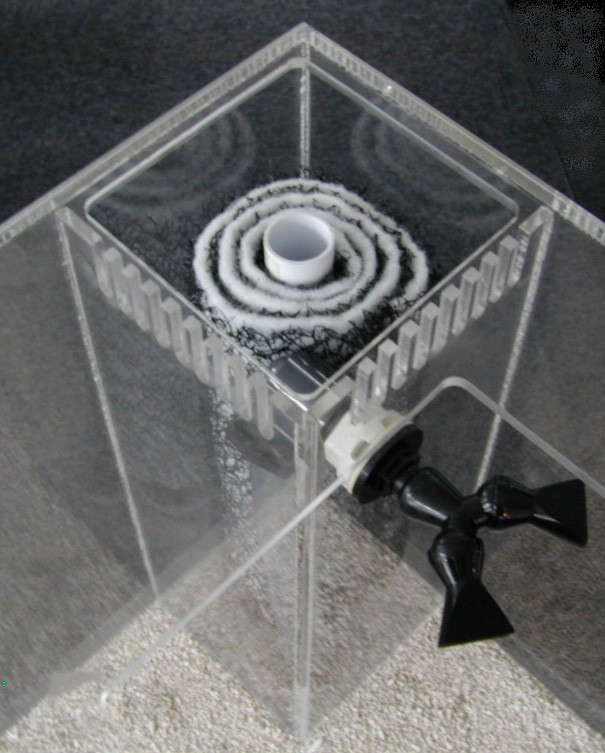
In all aquariums various
organic compounds, proteins and enzymes tend to collect at the surface
of the water. These compounds form a skin which inhibits the exchange of
gases such as carbon dioxide and oxygen from transferring between the water
and the atmosphere. An Overflow system is a box or pipe placed in the corner
or middle of the back of the aquarium. It can either rise up from the bottom
or elbow upwards from the rear of the tank. The Over Flow allows the water
at the surface to drop off into, or be skimmed from the surface, thus removing
this layer of organic skin and allowing the tank to breathe. The Overflows
water is then routed out of the bottom of the Overflow and down into the Wet Dry Trickle
filter system. AQUARIUM-DESIGN.COM offers this as an optional Overflow
Pre-Filter Package which includes the holes drilled for the exit and return
assemblies.
For the Undergravel and Canister filter approach acrylic tanks have long narrow slots across the top, back edge of the tank
to accommodate the inlet and outlets of canister filter, power filter, airlines and power cords.
Should you decide on a glass tank, or have an
existing glass tank, and do not want to have holes drilled into it there
are External Over Flow systems available. These units consist of a surface
skimmer box that sits down into the water allowing the surface water to
be drawn off. As the water fills the skimmer box this External unit uses
siphon tubes to draw the skimmed water out of the box, and then routes
it over the edge of the tank and into a prefilter box that hangs on the
back of the aquarium.
Both the Internal and External Over Flows allow
the waters organic skin layer to be drawn off, but the External requires
much more attention and maintenance. The reason for this is the Siphon
Tubes which are prone to filling with air, thus either affecting the overall
flow of water, all the way down to the return pump, or simply no longer
siphoning !
Within the Overflow Box, or External Overflow,
one places a filter media, such as a spiral filter pad, to separate or trap out the
large pieces of debri's that are drawn into the overflow system. This 'pre-filter'
media is your first type of filtration and it is called mechanical filtration.
Mechanical filtration is simply a media that traps out particles but lets
the water pass through. It is important to remember that this pre-filter
needs to be cleaned or replaced in time.
For the Undergravel and Canister filter approach glass tanks have a long plastic strip at the top back edge of the tank
that is easily trimmed to accommodate the inlet and outlets of canister filter, power
filter, airline and power cords.
As I mentioned in the beginning of this article,
the first step in building a good fish tank is to THINK about its design.
Hopefully this and future articles in this series will help you to achieve
that, but ultimately the reason for success is YOU and the effort that
is put into it. |

